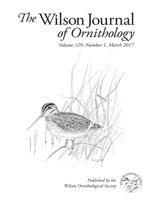Bird ornaments, such as plumage and song, can reflect the age of individuals. Knowledge of an individual's age and potential past breeding experience is important to future mates and to scientists studying mate-choice decisions, levels of parental investment, and reproductive performance. The iridescent length of hackles (throat feathers) has been used to sex and age adult European Starlings (Sturnus vulgaris). We confirmed that males have longer portions of hackle iridescence and overall longer hackles than females. Although After Second Year (ASY) adults have longer hackle iridescence than Second Year (SY) adults, only two other studies that we know of have examined the iridescent length of hackles in the same individuals over time. We measured hackle iridescent length of returning adults over 8 years, and discovered that it continues to increase with age in both females (25/26) and males (21/21). It had the greatest increase over the 1-year period when breeding adults switched from the SY to the ASY age category. Total hackle length also continued to increase with age, albeit more reliably for males (18/21) than females (13/26). These results demonstrate that hackle iridescence is a potential signal of age throughout the lifespan of a European Starling.
How to translate text using browser tools
1 March 2017
Length of hackle iridescence increases with age in European Starlings (Sturnus vulgaris)
Colleen A. Barber,
Megan M. Wright
ACCESS THE FULL ARTICLE
age
European Starling
hackle iridescence
hackle length
Sturnus vulgaris
throat feather





